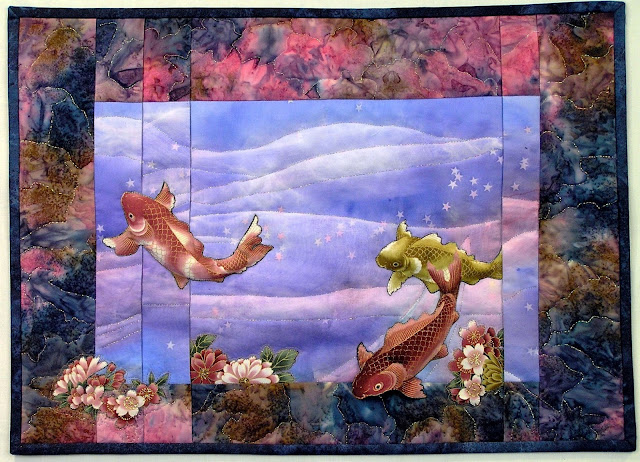Quilt No. 124
August 2018
August 2018
Ah, summer. Hot
weather, such hot weather. We’re
supposed to enjoy a pleasurable wallow in this sweaty scenario, but it can’t
all be Popsicles and gallon jugs of sunscreen.
While summer does lend itself to many appealing options for activities,
quilting is not always one of them. Often it's just too hot. Of course, you can
always take your quilting stuff outside, but it’s usually even hotter out there
than it is indoors. On the plus side,
the light is usually better out there, so at least you don’t need to drag your
OttLite with you. Forget about the ritual slathering of the sunscreen. A few dabs of that on a quilt and it will easily
collect enough dirt to take first place in the County Mud Pie Contest.
Short of indulging in madness, it’s pretty hard to deny that
we are in the grip of climate change.
Each year the extreme weather events notch up a little higher on the
scale. In this summer of 2018, hundreds
of forest fires in British Columbia Canada have given that pristine area the
worst air quality in the world. It’s so
smoky that tourists can’t even find the mountains. People are forced to hunker down indoors
hugging their air filters. Two thousand
kilometers away in the middle of Canada, Manitoba is sharing that bad air
quality thanks to the prevailing winds.
Here in Northern Ontario numerous fires threaten remote communities.
Pleas have gone out to forest fire fighters trained in previous seasons to rejoin
the effort. All these brave souls here
and in other countries will put their safety on the line to protect communities
and populated rural areas. But not
everything can be saved. For decades to come, people will be shocked when
driving through these burned over areas, the war zones of climate change. And while fires have always been a natural
part of the life cycle of the forest, it’s still a bitter pill to swallow when
we see an area completely spoiled with blackened trunks and exposed rocks.
I wasn’t actually thinking about how any of this related to
quilting when I started the quilt that became After the Fire. By late June it seemed that every quilt I had
started had become too large/hot/sweaty/complicated as I gave in to my usual
battle with heat induced Summer Funk. The only way for me to power through this
annual take down was to sweep all current projects under the bed and start a
new one. At least they could keep the dust bunnies company under there. The enthusiasm
of a new project can sometimes bring a full halt to Summer Funk. But on the down side, pulling together a new
bunch of fabric requires soooo many, many watts of heat-releasing brain power.
To avoid having to sift through drawers and boxes of fabric,
I turned to my scrap bag. My beloved
scrap bag has burgeoned into a bloated whale that would scare Captain Ahab out
of his socks and into a diaper. It even
has a companion bag that holds all the scraps with fusible ironed on the back. Mixing ready to fuse fabrics with plain fabrics is guaranteed
to ruin your iron, your ironing board cover, and your good nature. Like church and state, the only chance for
sanity rests in keeping these things strictly apart.
With no particular idea in mind I pulled out scraps,
favouring the blue ones. Hmm, didn’t
these resemble sky and water when laid horizontally in rows. Next, my eye fell on the wood grain fabrics. There were only a few narrow strips left,
since I’d used these in several other quilts, most notably LM + BD. What wonderful bare tree trunks these
fragments would make…
I had also recently acquired several fabrics from a friend’s
collection. Her sand coloured fabric was the perfect sand/rock fabric I
needed! I also liked the piece of lace
she had saved, and wanted to include it as part of the quilt. And so…another Scrap Bag Challenge quilt was
born. As it took shape I could see how
much it resembled the look of a forest after it had been swept by fire. When this happens there is a long pause after the trauma of
burning and before the green begins to shyly creep back. Bit by bit life reclaims its territory. It’s a humbling and patience-inducing experience
to watch this process of forest renewal.
Like real tree trunks, the ones on the quilt have a variety
of colours, due to different dyeing sessions for previous quilts. Here they ended up looking like different tree
species. I used Derwent Inktense Pencils to darken shadows on the left-hand side of
the trees, and to enhance the shadows on the ground. Machine quilting with silver metallic thread added
light to the right-hand side of the trunks.
The lace? Well, such a serious topic needed some sort of whimsical
element. Lace, like life, will always find a way.





